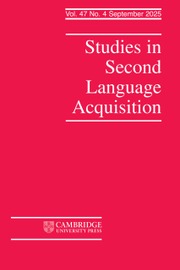Crossref Citations
This article has been cited by the following publications. This list is generated based on data provided by
Crossref.
Hancin-Bhatt, Barbara
2000.
Optimality in second language phonology: codas in Thai ESL.
Second Language Research,
Vol. 16,
Issue. 3,
p.
201.
Ota, Mitsuhiko
2000.
A review of two books introducing Optimality Theor y.
Second Language Research,
Vol. 16,
Issue. 3,
p.
281.
Alber, Birgit
and
Plag, Ingo
2001.
Epenthesis, deletion and the emergence of the optimal syllable in creole: the case of Sranan.
Lingua,
Vol. 111,
Issue. 11,
p.
811.
Archibald, John
2003.
Learning to Parse Second Language Consonant Clusters.
Canadian Journal of Linguistics/Revue canadienne de linguistique,
Vol. 48,
Issue. 3-4,
p.
149.
Matthews, John
and
Brown, Cynthia
2004.
When intake exceeds input: Language specific perceptual illusions induced by L1 prosodic constraints.
International Journal of Bilingualism,
Vol. 8,
Issue. 1,
p.
5.
Eckman, Fred R.
2004.
FROM PHONEMIC DIFFERENCES TO CONSTRAINT RANKINGS: Research on
Second Language Phonology.
Studies in Second Language Acquisition,
Vol. 26,
Issue. 4,
p.
513.
Major, Roy C.
2004.
Gender and stylistic variation in second language phonology.
Language Variation and Change,
Vol. 16,
Issue. 03,
Escudero, Paola
and
Boersma, Paul
2004.
BRIDGING THE GAP BETWEEN L2 SPEECH PERCEPTION RESEARCH AND
PHONOLOGICAL THEORY.
Studies in Second Language Acquisition,
Vol. 26,
Issue. 4,
p.
551.
Neri, Ambra
Cucchiarini, Catia
and
Strik, Helmer
2006.
Selecting segmental errors in non-native Dutch for optimal pronunciation training.
IRAL - International Review of Applied Linguistics in Language Teaching,
Vol. 44,
Issue. 4,
Davidson, Lisa
2006.
Phonology, phonetics, or frequency: Influences on the production of non-native sequences.
Journal of Phonetics,
Vol. 34,
Issue. 1,
p.
104.
Buchwald, Adam B.
Rapp, Brenda
and
Stone, Maureen
2007.
Insertion of discrete phonological units: An articulatory and acoustic investigation of aphasic speech.
Language and Cognitive Processes,
Vol. 22,
Issue. 6,
p.
910.
TAJIMA, KEIICHI
2007.
Relevance of Phonetics in Phonology (B. Hayes, R. Kirchner and D. Steriade (eds.), Phonetically Based Phonology).
ENGLISH LINGUISTICS,
Vol. 24,
Issue. 2,
p.
627.
권보영
2008.
The Effects of Gestural Overlap on the Acquisition of English Word-final Obstruent Clusters.
English Language and Linguistics,
Vol. null,
Issue. 25,
p.
149.
COLANTONI, LAURA
and
STEELE, JEFFREY
2008.
Integrating articulatory constraints into models of second language phonological acquisition.
Applied Psycholinguistics,
Vol. 29,
Issue. 3,
p.
489.
초미희
2008.
Asymmetries in the perception and production of the English incomplete off-gliding diphthongs by Korean speakers.
Studies in Phonetics, Phonology, and Morphology,
Vol. 14,
Issue. 3,
p.
483.
Cho, Mi-Hui
2009.
Confusion in the Perception of English Labial Consonants by Korean Learners.
The Journal of the Korea Contents Association,
Vol. 9,
Issue. 1,
p.
455.
Ro, Cheul-Woo
2009.
Reliability Analysis Modeling of Communication Networks Considering Rerouting.
The Journal of the Korea Contents Association,
Vol. 9,
Issue. 1,
p.
45.
SPARKS, RICHARD L.
PATTON, JON
GANSCHOW, LEONORE
and
HUMBACH, NANCY
2009.
Long-term relationships among early first language skills, second language aptitude, second language affect, and later second language proficiency.
Applied Psycholinguistics,
Vol. 30,
Issue. 4,
p.
725.
Sparks, Richard
Patton, Jon
Ganschow, Leonore
and
Humbach, Nancy
2009.
Long‐Term Crosslinguistic Transfer of Skills From L1 to L2.
Language Learning,
Vol. 59,
Issue. 1,
p.
203.
Lee ShinSook
2009.
Syllable Structure Constraints and the Perception of Biconsonantal Clusters by Korean EFL Learners.
The Journal of English Language and Literature,
Vol. 55,
Issue. 6,
p.
1193.

